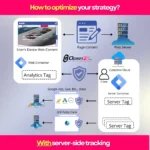An XML sitemap might sound like another piece of technical jargon that makes your eyes glaze over, but here’s the thing: it’s actually one of the simplest yet most powerful tools in your digital marketing arsenal. Think of it as your website’s GPS coordinates for search engines – without it, you’re essentially hoping Google stumbles upon your content by accident.
What Is an XML Sitemap and Why Should You Care?
Picture this: You’ve invested thousands in a beautiful website, but your traffic is flatlining. Sound familiar? Here’s what’s probably happening – search engines can’t properly crawl your site because they don’t have a roadmap. That’s exactly where an XML sitemap comes in. It’s essentially a file that lists all your important pages, telling search engines exactly what content exists on your site and how often it’s updated.
For small business owners and entrepreneurs juggling a million tasks, this might seem like just another technical headache. But here’s the reality: without a properly configured sitemap, you’re leaving money on the table. Every day that Google can’t find your pages is another day your competitors are stealing your potential customers.
The Real Cost of Ignoring XML Sitemaps
Let me share something that happens more often than you’d think. A client recently came to us frustrated because, despite having 200+ pages of quality content, only 30 were showing up in Google. The culprit? No XML sitemap. Once we implemented one, their indexed pages jumped to 180+ within weeks, and organic traffic increased by 40%.
This isn’t just about technical checkboxes. When search engines can’t find your pages, you’re essentially invisible online. And in today’s digital landscape, invisibility equals business death. Moreover, without proper indexing, all your SEO efforts become pointless – it’s like renovating a store that no one can find.
Common XML Sitemap Mistakes That Kill Your Rankings
Through our work with New Jersey businesses, we’ve seen these mistakes repeatedly:
- Including irrelevant pages: Your sitemap isn’t a dumping ground. Including low-quality or duplicate pages actually hurts your site’s credibility with search engines.
- Forgetting to update it: An outdated sitemap is like giving someone directions to your old address. As you add new content or restructure your site, your sitemap needs updating too.
- Wrong format or structure: Search engines are picky. One misplaced tag or incorrect URL can render your entire sitemap useless.
- Ignoring image and video sitemaps: If you’re running an e-commerce site or content-heavy platform, separate sitemaps for media files can significantly boost visibility.
How to Create an XML Sitemap That Actually Works
Creating an effective XML sitemap doesn’t require a computer science degree. In fact, with the right approach, you can have one up and running in less than an hour. The key is understanding what search engines actually want to see.
First, prioritize your most important pages. Not every page on your site deserves equal attention from search engines. Your homepage, main service pages, and high-converting content should take priority. Meanwhile, pages like your privacy policy or terms of service can take a backseat.
Essential Elements of a High-Performing XML Sitemap
Your sitemap needs several critical components to function properly:
- URL location (<loc>): The complete web address of each page
- Last modification date (<lastmod>): When the page was last updated
- Change frequency (<changefreq>): How often the content typically changes
- Priority value (<priority>): The relative importance of pages within your site
Example: XML Sitemap Code With Essential Elements
<?xml version="1.0" encoding="UTF-8"?>
<urlset xmlns="http://www.sitemaps.org/schemas/sitemap/0.9">
<url>
<loc>https://www.example.com/</loc>
<lastmod>2025-07-10</lastmod>
<changefreq>daily</changefreq>
<priority>1.0</priority>
</url>
<url>
<loc>https://www.example.com/blog/seo-best-practices</loc>
<lastmod>2025-07-05</lastmod>
<changefreq>weekly</changefreq>
<priority>0.8</priority>
</url>
<url>
<loc>https://www.example.com/contact</loc>
<lastmod>2025-06-25</lastmod>
<changefreq>monthly</changefreq>
<priority>0.5</priority>
</url>
</urlset>
Additionally, remember that search engines have limits. Google, for instance, won’t process sitemaps larger than 50MB or containing more than 50,000 URLs. For most small businesses, this isn’t an issue, but it’s worth keeping in mind as you grow.
XML Sitemap Best Practices for Local Businesses
If you’re targeting local customers in New Jersey or specific neighborhoods, your sitemap strategy needs special attention. Local businesses often have location-specific pages that are crucial for rankings but easy to overlook in sitemap planning.
For instance, if you’re a plumber serving multiple towns, each location page should be in your sitemap with appropriate priority levels. This tells Google that these pages matter for local searches, helping you appear when someone searches for “plumber in [specific town].”
Integrating XML Sitemaps with Your Overall SEO Strategy
Here’s where most businesses miss the mark: they treat sitemaps as a one-and-done task. But smart marketers understand that sitemaps are part of a larger ecosystem. Your sitemap should work in harmony with your SEM campaigns, content strategy, and technical SEO efforts.
Think about it this way: if you’re investing in Google Ads to drive traffic to specific landing pages, those pages better be easily findable by search engines too. Otherwise, you’re paying for traffic to pages that won’t build long-term organic visibility.
Advanced XML Sitemap Strategies for Growth
Once you’ve mastered the basics, it’s time to leverage advanced tactics that separate successful businesses from the rest. Dynamic sitemaps, for example, automatically update as you add new content. This is particularly powerful for businesses that regularly publish blog posts or add new products.
Another game-changer is implementing separate sitemaps for different content types. Consider creating dedicated sitemaps for:
- Blog posts: Helps search engines find your latest content faster
- Product pages: Essential for e-commerce sites
- Video content: Improves visibility in video search results
- News articles: If you publish time-sensitive content
Monitoring and Maintaining Your XML Sitemap
Creating a sitemap isn’t a set-it-and-forget-it task. Regular monitoring ensures it continues serving its purpose effectively. Google Search Console provides invaluable insights into how search engines interact with your sitemap, including which pages are indexed and any errors encountered.
Common issues to watch for include:
- Crawl errors: Pages that search engines can’t access
- Index coverage problems: Valid pages that aren’t being indexed
- Sitemap format errors: Technical issues preventing proper processing
The Connection Between XML Sitemaps and Conversion Optimization
Here’s something most SEO guides won’t tell you: your sitemap strategy directly impacts your conversion rates. How? By ensuring that your high-converting pages get properly indexed and ranked, you’re increasing the chances that qualified traffic finds them.
We’ve seen businesses double their conversion rates simply by restructuring their sitemaps to prioritize pages with strong conversion optimization elements. It’s not just about getting found – it’s about getting found by the right people at the right time.
XML Sitemaps and Site Architecture
Your sitemap often reveals problems with your site’s overall structure. If creating a logical sitemap feels like solving a puzzle, your site architecture probably needs work. A well-organized site naturally leads to a clean, effective sitemap.
This is particularly important for businesses undergoing web design and development projects. Planning your sitemap alongside your site structure ensures better user experience and search engine visibility from day one.
Common Questions About XML Sitemaps Answered
Do I need a sitemap if my site is small?
Absolutely. Even sites with just 10-20 pages benefit from sitemaps. In fact, smaller sites often see the biggest percentage improvements because every page matters more.
How often should I update my sitemap?
Ideally, your sitemap should update automatically whenever you add or modify content. If that’s not possible, monthly manual updates work for most small businesses.
Can I have multiple sitemaps?
Yes, and for larger sites, it’s recommended. You can create a sitemap index file that points to multiple specialized sitemaps.
Will a sitemap guarantee my pages get indexed?
No, but it significantly increases the chances. Think of it as giving Google a roadmap – they still decide which roads to travel, but at least they know all the available routes.
Do image and video sitemaps really matter?
Absolutely, especially if visual content is important to your business. They help your media content appear in specialized search results like Google Images and Video searches, creating additional traffic opportunities as discussed in our SEO content guide.
Taking Action: Your XML Sitemap Roadmap
Ready to stop leaving money on the table? Here’s your action plan:
- Audit your current situation: Check if you have a sitemap and whether it’s properly submitted to search engines
- Identify priority pages: List your most important pages for business goals
- Create or update your sitemap: Use tools or plugins appropriate for your platform
- Submit to search engines: Don’t just create it – make sure Google knows about it
- Monitor performance: Set up tracking to ensure everything works correctly
- Schedule regular reviews: Add sitemap checks to your monthly marketing tasks
Remember, in today’s competitive digital landscape, every advantage counts. While your competitors are wondering why their beautiful websites aren’t generating leads, you’ll be systematically improving your visibility and capturing more customers.
For businesses looking to strengthen their overall search strategy, don’t miss our guide on developing a comprehensive SEO strategy that works alongside your sitemap implementation.
The bottom line? An XML sitemap isn’t just another technical requirement – it’s a fundamental tool for business growth. Without it, you’re essentially running a business with the lights off, hoping customers stumble through your door. Turn on the lights, create that roadmap, and watch your online presence transform from invisible to unmissable.







